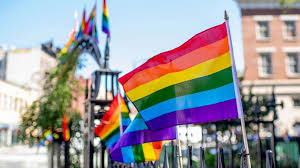507
By Myke Agunwa
Despite strict regulations within the Catholic Church, thousands of Lesbians, Gays, Bisexuals, Transgender people, and Queers (LGBTQs) Catholics and their supportersLGBTQ participate in first pilgrimage at Vatican, seeks inclusion are attending a pilgrimage at the Vatican for the first time this weekend.
The pilgrimage is a gathering of around 1,400 individuals from roughly 20 countries, as part of the Catholic Church’s Jubilee Holy Year. It was organised by La Tenda di Gionata (The Tent of Jonathon), an Italian association campaigning for greater inclusion among the faithful. Participants were not permitted a private audience with Pope Leo XIV.
Although LGBTQ groups have previously visited the Vatican, this marks their first official presence at the pilgrimage, included in the official Jubilee programme.
Yveline Behets, a 68-year-old transgender woman from Brussels, walked 130 kilometres (80 miles) with an additional 30 LGBTQ individuals along part of the historic Via Francigena pilgrimage route to reach Rome.
She expressed her hope for more “plurality” within the Church after facing difficulties with other Catholics, among whom she said, she does “not always feel acknowledged”.
“One should not misuse the word ‘welcome’. We are not simply outsiders who are occasionally welcomed; we are part of the same family,” she said, wearing a T-shirt with the rainbow colours of the LGBTQ community.
Just as millions of other pilgrims have done, those taking part in the LGBTQ pilgrimage were scheduled to walk up the main road to the Vatican on Saturday, passing through the Holy Door into Saint Peter’s Basilica.
On Saturday morning, hundreds of them attended a Mass at the Church of the Gesù, in central Rome. The night before, they held a prayer vigil.
Hugo, a 35-year-old from Quebec in Canada who declined to give his last name, said he believed the LGBTQ pilgrimage was “a really important signal for us to feel more included”.
He hoped it would “allow people who are on the fence to be more welcoming towards homosexuals in the Church”.
However, within a religious institution that for two thousand years has regarded homosexual acts as contrary to its doctrine of procreative sex and gay couples as “intrinsically disordered”, the journey towards acceptance remains lengthy.
“There are fears and a sort of misunderstanding when it comes to the life that homosexuals lead,” Hugo stated. “If everyone got to know each other, I think many barriers would come down.”
At present, he added, “a lot of obstacles remain”, especially for couples seeking the Church’s blessing for same-sex marriages.
Pope Francis, who died in April, aimed to make the Catholic Church more open to all and made many gestures of outreach towards the LGBTQ community, without altering doctrine.
His 2023 decision to permit priests to bless same-sex couples sparked fierce opposition from conservative factions within the Church, especially in Africa.
His successor, Pope Leo, has reaffirmed that marriage is a union between a man and a woman but has stated he will not reverse Francis’s decision.
Beatrice Sarti, an Italian woman accompanying her gay son on the weekend pilgrimage, said there “is still a long way to go”, beginning with changing mindsets among Catholics.
“Many of our children no longer go to church… because they are made to feel that they are wrong. That absolutely needs to change,” said the 60-year-old from Bologna, who is a member of La Tenda di Gionata.
“The first step is to train educators, seminarians, priests and bishops, starting at the grassroots,” she concluded, while recognising that “it is a very long process”.



